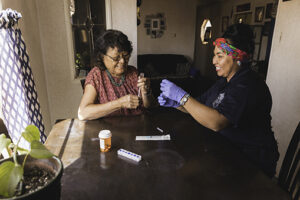Was the medical terminology communicated accessibly?
Why is this indicator important to First Nations, Inuit and Métis?
For many reasons, First Nations, Inuit and Métis may have a distrust of hospitals and the health care system.

This distrust, coupled with many care providers’ limited knowledge and lack of understanding of Indigenous Peoples, history and cultural differences, can give rise to poor communication concerning First Nations, Inuit and Métis cancer care needs.
Barriers to good communication stem from differences in language, communication styles, knowledge and use of medical terminology and cross-cultural differences around concepts such as time.
View Indigenous determinants of health
How does this affect care and outcomes?
 Being able to ask questions and being able to understand and be understood makes a huge difference in the patient’s overall experience in hospital.
Being able to ask questions and being able to understand and be understood makes a huge difference in the patient’s overall experience in hospital.
Good communication with care providers in ways patients can understand allows them to understand their care and treatment plan and supports them in taking an active role in their healing journey.
Medication is a big part of care. Clear explanations about what the medications are, their purpose, how to take the medications and possible side effects can help prevent medication errors.
Towards health equity
 To improve the delivery of cancer care for Indigenous Peoples and to remove barriers to care provision, communications with respect to medical terminology that are clear, responsive to cultural differences and patient-centred are needed.
To improve the delivery of cancer care for Indigenous Peoples and to remove barriers to care provision, communications with respect to medical terminology that are clear, responsive to cultural differences and patient-centred are needed.
What this would mean for people in Canada
Indigenous Peoples with cancer will receive communications and information about their care in understandable and culturally appropriate ways.
There will be improved understanding of cancer and the cancer journey.
View indicator development process
View ways of measuring the indicators

